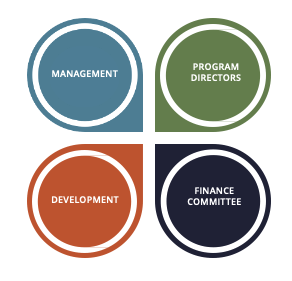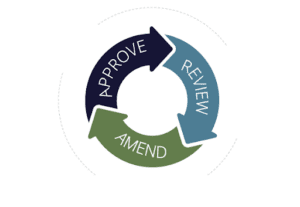Perfect Your Budget for 2022: Best Practices for Nonprofit Leaders
Working on a budget for 2022? Creating budgets for your nonprofit programs in addition to an overall budget for your organization can seem like overwhelming tasks. Budgeting requires careful record-keeping, evaluation of the past, consideration of the future, and a thorough understanding of your organization’s current context.
And here’s the punch-line: you won’t get it right!
The thing is, the purpose of a budget isn’t for it to be right. The purpose of a nonprofit budget is for it to reflect your realistic financial goals and plans for the upcoming year. The purpose of a nonprofit budget is to provide your organization with a roadmap that will help you plan, make decisions, and adjust the plan when things don’t go exactly as expected so that you can stay on track as the year unfolds.
Why Is a Budget So Essential to Nonprofit Accounting and Operations?
A nonprofit budget is, perhaps, the most important financial document for your organization because it is not only a financial management tool but also a strategic tool.
As a financial management tool, the budget outlines how your organization plans to use its money, breaking down your anticipated revenue along with forecasted direct and indirect expenses. The budget includes everything: programs, events, fundraisers, employee costs, rent, utilities, and more.
When used as a tool for strategic planning, a budget enables you to do the following:
- Coordinate operations around both short and long-term goals
- Fine-tune your operational strategy
- Make informed decisions
- Conduct more productive board meetings
- Provide better direction to your nonprofit finance committee
- Improve fundraising efforts with better-informed donors
- Easily monitor the use of mixed-purpose funds
- Make the best use of your funds overall
- Stay on track financially
Types of Budgets for Nonprofits: Which Is Best for Your Organization’s Budget for 2022?
Before you start a budget for your nonprofit, you must first understand that there are different types of budgets. Furthermore, it’s important to remember how each type serves a slightly different purpose. Knowing which type of budget you adopt will help you ask yourself the right questions and gather the right information for creating the most accurate budget.
The Incremental Budget
An incremental budget is based on your organization’s financial history. To create this budget, you start with the previous year’s budget and build on it, adjusting figures and adding or removing line items as necessary. With this type of budget, unspent funds are either deleted or reallocated.
An incremental budget requires the least amount of work. However, it can have a tendency to perpetuate financial problems, unproductive programs, and money waste in an organization. This is because it doesn’t require you to really comb through and evaluate each program and expense individually.
The Zero-Based Budget
A zero-based budget starts from scratch with a blank slate every year. While you can (and should) use the previous year’s numbers to estimate upcoming expenses and income, you should carefully evaluate each one. Assess whether the expense is worthwhile, whether the program is generating an acceptable ROI, and whether you can expect to receive similar donations from your existing donors.
With zero-based budgeting, expenses are more carefully evaluated. To earn their place in the budget for another year, costs typically need to be tied to real results.
Additional Types of Nonprofit Budgets
The incremental budget and zero-based budget are the two most commonly used budget types in nonprofit organizations. There are, however, a few other types of budgets that are worth mentioning:
- Surplus Budget—Some nonprofits build a surplus into their budget in order to set aside rainy-day funds, pay off debt, or cover an expected upcoming decrease in funds.
- Deficit Budget—A deficit budget is one in which an organization plans for its expenses to exceed income. Typically, it is not advisable to operate with a deficit budget. There are a few exceptions, such as if the deficit has a time limit and represents a real investment in the organization like an expansion project.
- Break-Even Budget—A break-even budget is one that reflects an upcoming deficit or shortfall in funds. Rather than cutting line items, the nonprofit leaders focus on fundraising to increase funding and address the deficit.
- “Known Risk” or “What If?” Budgets—It can be advisable to create a “known risk” or “what if?” budget for the purpose of evaluating potential risks or unexpected costs that could result in a cash flow shortage. Look at the conditions your organization is currently facing and create a budget for a worst-case scenario so that your nonprofit will always be prepared to weather financial storms.
12 Nonprofit Budget Best Practices for Better Financial Management in 2022
1. Remember Your Budget for 2022 Will Be Wrong
It’s important to restate that your budget won’t be exactly right. No one can see the future. So, while creating your budget, remember that the numbers you choose to put down represent your best guess and nothing that you put in the budget is set in stone. Pro tip: stay on track by having a helpful Nonprofit Budget Guide handy.
2. Start Early and Follow a Set Process
Although it’s never too late to make a budget, the process should ideally start two or three months before the beginning of your next fiscal year. This allows you enough time to gather all the information you need and to present the budget to your nonprofit board for approval.
3. Work Together
No nonprofit executive director is an island, and this is especially true when it comes to making a budget. Delegate as much of the process as you can to your development employees, program directors, and finance committee members. Having your program directors carefully create budgets for each of their programs will knock out a big portion of the data you need to produce an overall nonprofit budget. You can then focus on the rest of the organization’s expenses and funds.

Making it a team effort will help you create a more accurate budget.
4. Context Is Key
When it comes to budgeting, context is essential when considering every item. Think about where your organization is right now, the current donor climate, and your current expense climate. Do you suspect that your building’s AC unit is about to go out? Or perhaps you have other unusual expenses, fund shortages, or fundraising windfalls that you need to make special plans for.
5. Use Your Numbers
When making a budget, rely on your numbers—not your gut. Historic data is the most reliable information you can use for creating a budget. Just be sure that you’re using timely and accurate historic numbers when forecasting future expenses and revenue.
6. Be Realistic for Your Budget for 2022
Dreaming is for writing mission statements. When making a budget, it’s okay to be optimistic. But it’s essential that you be realistic, especially when it comes to estimating the upcoming year’s revenue.
7. Sort Your Expenses
Keep your expenses sorted into categories (fixed and variable), and maintain a budget for capital expenditures that is separate from your operational budget.
8. Include Non-Monetary Contributions
Remember to include, record, and track non-monetary contributions with you budget. This might include volunteer hours or non-monetary contributions such as vehicles or other equipment. These are also known as in-kind donations. List them so that the value zeroes out while still being accounted for.
9. Focus on Cash Flow
When budgeting, keep an eye on your cash flow forecasting. For example, if you know that you have a big expense coming in the spring but do not receive the majority of your funds until year-end fundraising, it’s important to realize that you could experience a cash shortage that you will need to plan for accordingly.
10. Make Note of Your Assumptions in your Budget for 2022
If you make any assumptions (and you probably will) while creating your budget, be sure to make note of those assumptions. As a result, you can keep a careful eye on your guesswork. Perhaps some guesses will be little less educated than the other numbers on your budget, so adjust your numbers if needed.
11. Shoestring Budgets Are Risky
Operating with a shoestring budget is risky. For this reason, it’s best to budget with a 3-5% surplus written in. This gives you a bit of wiggle room if your cost estimates came in low or your revenue estimates turned out to be too optimistic.
12. Revisit Your Budget for 2022 Every Month
Creating and making the most of a nonprofit budget isn’t a one-and-done job. You should revisit your budget every month and compare it to your actual numbers. This allows you to keep a close eye on your strategic plan for the year and where how your nonprofit is actually performing.

Compare Budget Vs. Actual to Stay on Top of Variances
As you go along, don’t be afraid to make changes and adjustments to your budget to better fit the year’s actual numbers. By making continuous adjustments, you can keep your nonprofit on track to successfully complete another year.
Streamline Budget Creation and Budget vs. Actuals Evaluation With an Affordable, Automated Back Office
Many nonprofit leaders assume they can’t afford the type of back-office that’s required for effective nonprofit budgeting and comparing budgets vs. actuals. This, however, is not the case. Like small for-profit businesses with limited resources, nonprofits can also take advantage of the many benefits of outsourced accounting service providers—like GrowthForce—that are highly experienced in and specialize in accounting for nonprofits.
Nonprofits have intricate needs and face unique challenges that most accounting services don’t have experience in. That’s why I created GrowthForce: to help and serve this overlooked group of nonprofits. With over 35 years of nonprofit financial management experience, I’ve single-handedly seen the difference it made when organizations used accounting as a fundraising tool.
For a fraction of the cost of an in-house bookkeeping and accounting department, outsourced providers give your organization access to the tools, technology, and experienced teams of accounting professionals who can show you how to leverage your back office and your annual budgeting to take your mission to the next level.
*This spotlighted blog post is courtesy of GrowthForce
About the Author
From tech founder to nonprofit CFO and fundraiser, Stephen King brings a unique combination of vision, foresight, and experience to help nonprofits maximize their cash flow and operational efficiency. He’s been a dedicated board member of many nonprofit organizations – including seven years working for Amnesty International USA – where he was the Director of Development and Chief Financial Officer. His time at Amnesty reinforced Steve’s life-long commitment to giving back to the community through charitable causes. Regarded as one of the accounting industry’s top thought leaders, he’s currently serving as President & CEO of GrowthForce, a heart-centered company with specialized teams providing accounting for nonprofits. Learn more about GrowthForce by connecting on LinkedIn.
The post Perfect Your Budget for 2022: Best Practices for Nonprofit Leaders appeared first on Nonprofit Hub.









Leave a Reply